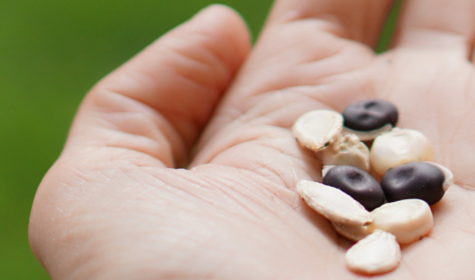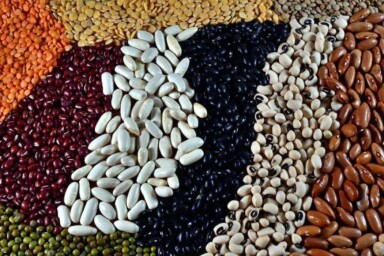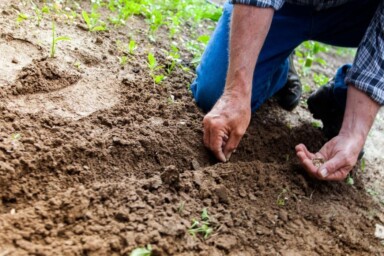What is seed sovereignty and why is it threatened?
The Lexicon of Food defines seed sovereignty as “the farmer’s right to breed and exchange diverse open source seeds which can be saved and which are not patented, genetically modified, owned or controlled by emerging seed giants”.
Throughout history, seeds have been bred and shared openly between farmers, communities and governments. However, a major shift occurred following World War Two with the transition from open-pollinated to hybrid seed. With the task of feeding a growing population, agricultural scientists bred crops for yield, nitrogen uptake efficiency, pesticide resistance and shelf life. Hybrid seed became increasingly productive and widely available.
With hybrid seed, farmers could choose more productive varieties that required less labour. A decreased demand for labour facilitated urbanisation throughout the 20th century, which also meant a general loss of knowledge of how to farm, as people moved out of rural areas. Access to hybrid seed as well as declining numbers of farmers also led to a loss of seed saving expertise, and since the green revolution 75% of agricultural biodiversity on earth has been lost. Reclaiming biodiversity is thus a critical goal of the seed sovereignty movement.
Hybrid seed has eroded seed sovereignty through the use of patents. Breeding a single hybrid variety can take up to 30 years and requires significant labour and investment. Acts such as the Plant Variety Protection Act in the United States and the establishment of the International Union for the Protection of New Varieties of Plants based in Geneva have helped to secure intellectual property rights for breeders. Currently, farmers who purchase hybrid seed are prevented by intellectual property laws from saving seed year to year. Hybrid seed is generally their only choice – it is so dominant in the marketplace that farmers now struggle to access non-hybrid varieties, giving large seed breeders a near monopoly on what crops are grown.
The patent system is also notorious for biopiracy. Traditional plants around the world such as neem, ayahuasca, maca and basmati rice have been patented by biomedical and food companies, often after being taken from local communities without their consent. In response to biopiracy, food sovereignty movements like La Via Campesina have taken a primarily protectionist and reactionary approach by blocking bills that prohibit sharing seed or blocking access for companies such as Monsanto from selling their hybrid and often transgenic seed in developing nations. The most recent success was seen in Guatemala this month, where a law that would have given exclusivity on patented seeds to a handful of transnational companies was defeated following protests. But is a reactionary approach sufficient?
The issues surrounding hybrid seed are not black and white. While its ‘evils’ are frequently discussed, the advantages must also be recognised. In addition to increasing food availability worldwide, hybrids have given farmers a choice to use more productive seed, which requires less labour. For subsistence farmers and their families, this might hugely impact their lives – for example, by allowing them to send their children to school. Seed diversity is recognised as critical to agricultural adaptation and resilience. Yet it is ironically colonial to place the burden of seed preservation on rural, subsistence farmers who may find greater economic success planting hybrid or transgenic varieties. That said, access to diverse, non-patented varieties is critical to the resilience of small-scale farming, especially in extreme climates.
Climate change, genetic drift and biodiversity loss
While societies have developed food sovereignty definitions and doctrines, nature rarely plays by human rules. Genetic drift and climate change challenge our assumptions and force us to take more proactive steps towards seed conservation and sovereignty.
In any plant population, different varieties pollinate one another by wind, insects or animals. If you and your neighbour plant the same crop, the two populations will cross-pollinate. As agriculture has expanded into previously uncultivated areas and farms have become more densely packed, genetic drift has become a more serious problem. This controversy has predominantly emerged with regards to transgenic crops. If you plant a transgenic crop but your neighbour opposes GMOs and plants only heirloom varieties, your populations will inevitably cross-pollinate and your neighbour’s seeds will contain DNA from your plants (and vice versa). As a result, you will have introduced patented seed into your neighbour’s field. This issue has resulted in multiple court cases, including Monsanto Canada Inc. vs. Schmeiser. This begs the question: if a farmer chooses to use transgenic seed, does he or she impede the sovereignty of neighbours when genetic drift occurs?
To be clear, land race (heirloom) varieties also cross-pollinate, and better agricultural planning and accessible seed storage technology must be implemented if seed lines are to remain truly ‘pure’. This requires proactive measures to ensure biodiversity conservation and public access to land race seeds.
Climate change further complicates the issues. In Peru, for example, potato farmers in the Andean Altiplano have maintained 4,000 potato varieties for millennia, but climate changehas made their environment increasingly unpredictable. In many places temperatures no longer drop sufficiently low to practice traditional freeze-dry preservation methods, and seed storage has become less secure due to unstable climatic conditions, as seeds must remain in permanently cool, dry conditions to retain viability. So the farmers are turning instead to large-scale seed banks such as the International Potato Center (CIP), an internationally funded public institution that has supported Andean farmers by carrying out research with them. However, CIP was partially blamed for releasing germplasm of maca, an Andean root vegetable, to a US company that later patented it.
The case of the Peruvian potatoes also highlights the potential for creative solutions. CIP created a groundbreaking repatriation agreement giving farmers access to potato varieties stored in their gene bank and paved a road for future public sector collaboration. This highlights the fact that communities, particularly in low-income nations, often lack the infrastructure to save their own seeds. If the food sovereignty movement aims to support farmers and biodiversity, greater focus is needed on developing collaborative relationships that make research and seed storage more publically accessible, especially to small-scale farmers.
What to do now?
This question is difficult, and can often seem distant to those not directly involved in food sovereignty work. However, there are simple, tangible steps that we can take in our own communities to work towards seed sovereignty.
- When buying garden seeds, buy open-pollinated varieties. Organisations such as Seed Savers Exchange, Native Seeds/SEARCH and many others have worked for decades to maintain seed diversity and to make heirloom varieties accessible to the public.
- Learn to save seeds. The organisations listed above frequently host webinars and provide online guides.
- Re-zone your neighbourhood to allow community gardens where seeds and seed education can be shared.
- Share seeds, along with their stories – seeds can connect us to our family histories, neighbours, and landscapes. These connections facilitate understanding as well as conservation.
- Start or join a seed library.
These approaches will not eradicate the patent system, reverse the impacts of climate change or put an end to the exploitation of small-scale farmers. However, learning to save seed, becoming informed about seed justice and standing up for seed rights in our communities and on political platforms are critical first steps to attaining food sovereignty around the world.






